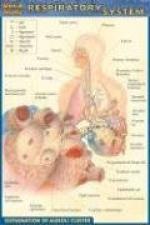|
This section contains 1,604 words (approx. 6 pages at 300 words per page) |

|
The human respiratory system, working in conjunction with the cardiovascular system, supplies oxygen to, and removes carbon dioxide from, the cells of the body. The respiratory system conducts air to the respiratory surfaces of the lungs. There, the blood in the lung capillaries readily absorbs oxygen and gives off carbon dioxide gathered from the body cells. The circulatory system transports oxygen-laden blood to the body cells and picks up carbon dioxide. The term respiration describes the exchange of gases across cell membranes both in the lungs (external respiration) and in the body tissues (internal respiration). Pulmonary ventilation, or breathing, exchanges volumes of air with the external environment.
The human respiratory system consists of the respiratory tract and the lungs. The respiratory tract can be divided into an upper and a lower part. The upper part consists of the nose, nasal cavity, pharynx (throat), and larynx (voicebox...
|
This section contains 1,604 words (approx. 6 pages at 300 words per page) |

|


